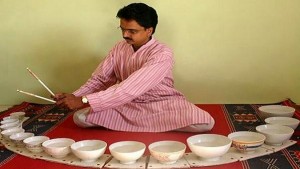Jaltarang is a popular Indian classical instrument. It has been used quite a lot in Indian classical music in ancient times. Its literal meaning is “waves in water”. It is also known as Jal-Yantra or the Jaltarangam. The sound is created using waves in water. The water in kept in cups placed around artist. Earlier, bronze or porcelain cups were used mostly but now a days, artists prefer bone china cups more. This musical instrument needs very less expenditure for learning and playing. It is a solo instrument and accompanied by table while playing or it accompanies music while Kathak is practiced.

A deep understanding is required to play this instrument. The pitch of the sound is adjusted by varying the quantity of water in cups. Different scales are played by adjusting size of cups. The number of cups to be used depends on which melody is being played. The cups are arranged in semi-circle fashion around the artist so that he can reach out to all the cups conveniently and easily. Cups are either played on table or on ground. Mostly, artists sit on ground and play it instead of standing. Bigger bowls create deeper sound than smaller ones and are placed starting from left of the artist to the smallest bowl at the right of him. Bamboo sticks are used to strike the cups gently. It requires immense practice and expertise to strike the bowls. Some artists like Seetha Doraiswamy also used plastic sticks to create variations in tone.
Various challenges associated with playing the instrument are tuning the instrument. For each raga, the instrument needs to be tuned which means the quantity of water in each cup needs to be adjusted for that particular raga. Other than this, there is a great risk of the bowls getting cracks or breaking while a concert is going on.
The current status is that it is rarely played in any musical concerts. It is very sad to know that in the past ten years, it is not played in any concert. It is getting obsolete because of the popularity of western music. It is a dying art and facing the problem of exposure. It gets very less exposure and people hardly know of this instrument. Even the new artists often do not consider taking up a career in it because it has very less reach even though its sound is so pleasant.
The Indian Council for Cultural Relations (ICCR) has taken initiative to ensure the survival of this instrument. They organized concert in Delhi and have also planned to organize concerts abroad to increase awareness about it. Besides, various current players want to pass this art to next generation and in lack of awareness, there is lack of good students willing to opt for this instrument. For example, Seetha Doraiswamy has taught 15 students till now and her grandchildren also. She wants to pass this art to even more people. Seeing the current trends, one solution is to upload some free music on internet websites and then when people listen for free and like it, artists should then try selling their music to such people. This is because most people now a days prefer downloading and listening first before buying. So, this can create a cycle for current as well as future Jaltarang artists.